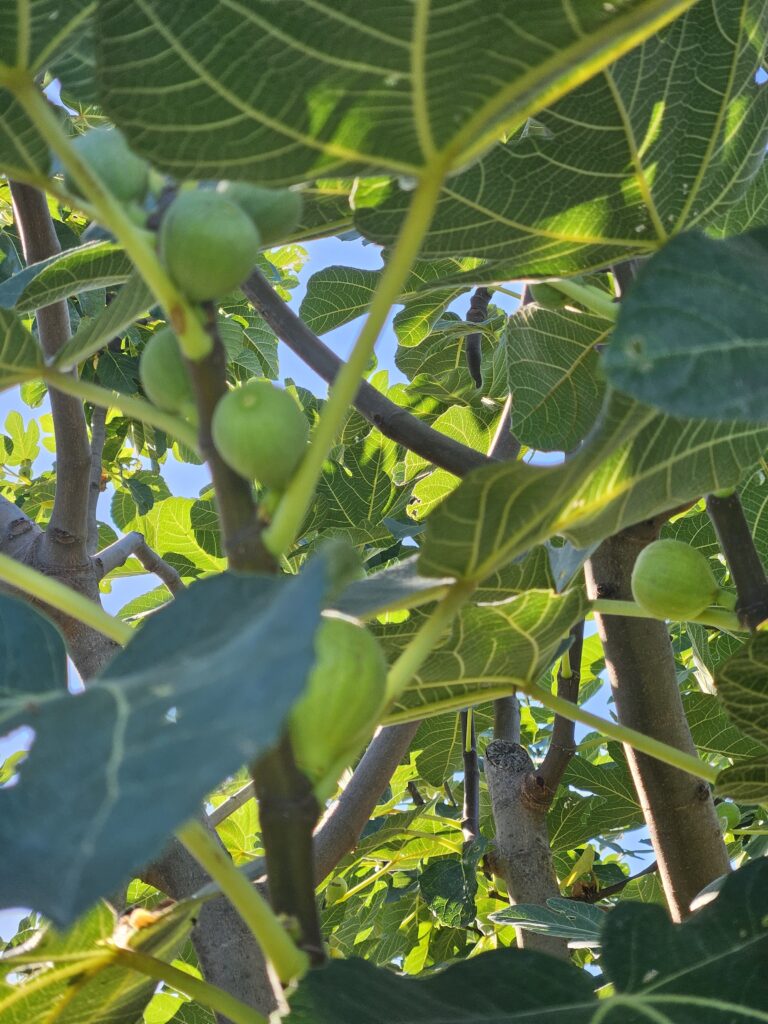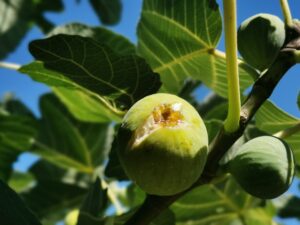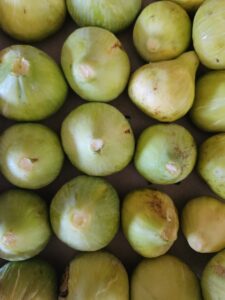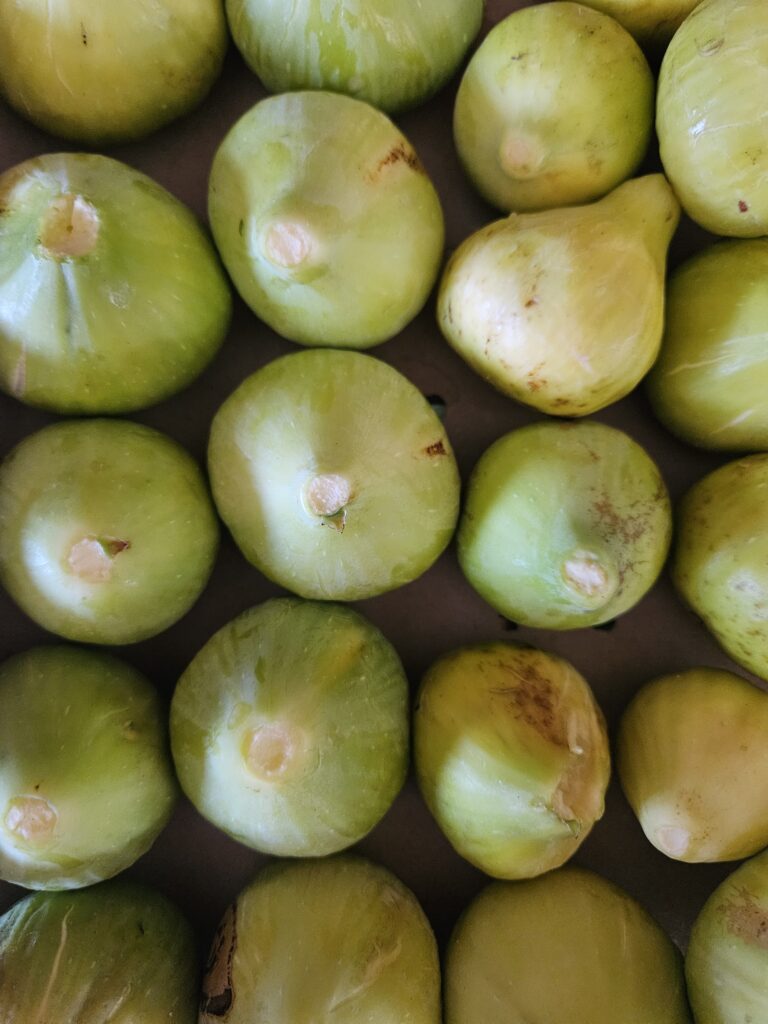THE WHITE ADRIATIC FIG TREE
In local dialect “Lu Ficu de la Signora”
Ficus carica L.
Moraceae
🍐The white Adriatic fig is one of the most ancient cultivated fruit trees, with this variety dating back to around 11,000 years ago. This particular white fig is called “lu fico de la signora” (literally “the lady’s fig”) due to a well-read, travelling noblewoman from Macerata. She imported it in the 1800s and encouraged everyone to plant this tree in their garden because of the sweetness of its fruit.
📍 Origin: The fig tree came from the Middle East, and it spread rapidly in the Mediterranean, becoming a symbol of abundance and fertility.
🌳 Hardy and resistant: this is a medium-sized tree, ranging from 3 to 10 meters in height; it has a short trunk and twisted branches. Its leaves are large, lobed and bicolored: the upper side is bright green, while the lower side is lighter.
🌱Cultivation
The white fig tree is a hardy plant, ideal for organic orchards thanks to its natural disease-resistance.
🍯 Refined fruit: This fruit, which is technically a syconium, is a fleshy inflorescence that contains the real flowers inside. The white fig has a thin, light peel, ranging from light green to yellowish-white in colour, and a sweet, juicy pulp that ranges from amber to pinkish.

📖HISTORICAL MENTIONS
✒️ In his letters, Giacomo Leopardi, a very well-known poet from the Marche Region, talks about “fichi Bianchi della Marca” (“marquise’s white figs”) and he describes them as the best of all.
Bologna 8 Febbraio 1826.
Carissimo Signor Padre.
Ricevo la cara sua dei 31 Gennaio. Già fin dal primo di questo mese, il freddo qui, grazie a Dio, è molto scemato, anzi abbiamo avuto qualche giorno quasi di primavera: io ho ripreso le mie passeggiate campestri, e mi pare di esser rinato. Non ho ancora veduto Fusello. Il dono che Ella mi manda mi sarà carissimo, e mi servirà per farmi onore con questi miei amici, presso i quali trovo che l’olio e i fichi della Marca sono già famosi, come anche i nostri formaggi,
Bologna 20 Febbraio 1826.
Carissimo Signor Padre.
Quando mi giunse la sua dei 12, io aveva già poco prima riscossa finalmente la roba portata da Fusello. I fichi e l’olio sono qui applauditissimi e graditissimi, e quantunque in casa io non fossi solito di mangiar de’ fichi, adesso, non so come, trovo che sono pure una cosa di un sapore eccellente, e ho pensato di salvarne un poco anche per me, giacché Ella me ne ha favorito così liberalmente che ve n’è abbastanza per me e per gli altri.
✒️ In his poem Il Fico (The Fig), Giovanni Pascoli, a very well-known Italian poet, uses this fruit as a metaphor for loneliness and sweetness.
📖 “Dolce, solitario, abbandonato,
ma dal sole sempre baciato.”A fair translation of this poem is: Sweet, alone, abandoned, but always sun-kissed.

📜 MYTHS AND INTERESTING FACTS
🏛️Symbol of fertility and knowledge: In Ancient Rome, the fig tree was sacred to Romulus and Remus, because the wolf who fed them was found under a wild fig tree, the Ficus Ruminalis, at the foot of the Palatine hill.
🥇Food of Greek athletes: The Olympic champions were awarded with crowns of fig leaves and dried figs, since they were considered a highly energetic food.
🍃Traditional uses: traditionally, the fig latex was used to remove warts and calluses thanks to its caustic properties.
🌙 Popular beliefs: it is said that sleeping under a fig tree causes odd dreams and visions, because of the sharp scent released by its leaves on hot summer nights

🏡 BACK TO THE PRESENT
⚠️ Today it is considered a minor or ancient fruit, less widespread than other more commercial varieties.
🥄However, its unique taste makes it ideal for:
✔️Dried or sweet-and-sour figs
✔️ Syrups and traditional desserts
🍯Culinary traditions
📜 In Italian gastronomy, white figs are often paired with honey, seasoned cheeses and nuts, or used in desserts and homemade liqueurs.
Since ancient times, the white fig has been linked to history and mythology. It is a precious fruit to be rediscovered for its natural sweetness and symbolic value.
These contents were written and researched by the owners of the SiGi Agricultural Company in collaboration with the students of the Agricultural Technical Institute of Macerata.
If you would like to contribute to expanding the descriptions of these varieties, you can send an e-mail to info@agricolasigi.it
We launched the e-museum of ancient fruits thanks to a social farming project of the Marche region. The translation is by komalingua
This project enabled five young people with cognitive impairments, aged 20 to 25, to work on the farm. They were selected by psychologists and Anffas social workers, supported by the professional educator Il Faro and supervised by UniMc researchers. Coldiretti Marche handled communication and distribution.
This unique and challenging project led to the creation of both a physical and virtual museum of ancient fruits in SiGi’s garden. This is not only a great honor but also a significant commitment that we are willing to continue with everyone’s support. You can contribute to our projects by choosing our products, or you can do so directly here:

